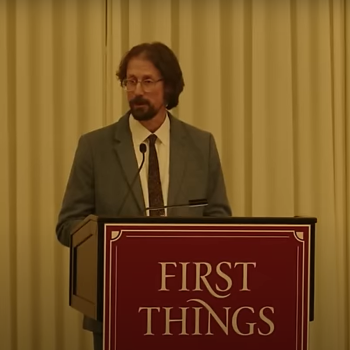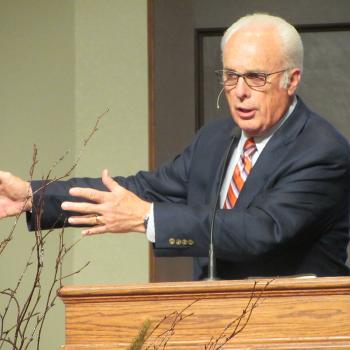
Like most people following the Ravi Zacharias scandal, I knew the full report of his misconduct would be bad when it came. The only question was how bad. Now that it’s dropped, we have the whole ugly picture. Calculated side deals, manipulation, Inception-like layers of deception. A man who publicly preached the vital importance of private virtue, yet ostracized anyone who dared to scratch the facade. For those on the outside of the scandal looking in, the story may not seem particularly shocking. Why should anyone be shocked that a powerful, charismatic religious figure gamed the system for sexual perks? But within the evangelical and apologetics communities, the shock-waves are going to be felt for a long time to come.
There are many hard lessons to be learned from this, including lessons about the culture that enabled Ravi to get away with his crimes for so long. It is now emerging that multiple people failed to act on what should have been clear warning signs, simply because they were blinded by loyalty. Ravi’s two-faced act made it beyond unthinkable to them that he might be concealing sin of this magnitude. And so it continued to lie concealed, right up to the day of his death.
Some would say this is the main or only takeaway, and that there’s little point or use in reflecting on how Ravi himself came to be as he was. And perhaps one should raise an eyebrow at people saying “That could easily be me” over such an elaborate, pre-meditated pattern of ongoing duplicity. At the same time, I maintain it’s not a bad thing if this becomes an occasion for some men to do a bit of soul-scouring when it comes to their own pride and lusts. In my earlier reflection on this scandal, I made the analogy to Gandalf’s refusal of the One Ring in LOTR. He refuses it because he knows no one soul can handle that much power.
As I was reflecting on all this recently, my mind went back to another figure who was a “celebrity Christian” in his own way, yet attained this status reluctantly, almost by accident. This figure also had a magnetic appeal, also had a lucrative and popular ministry, and also used his platform to address the challenges of the Christian walk. He also spoke often about sin, grace, moral purity and spiritual integrity, while wrestling with private sin. I’m speaking about Christian singer-songwriter Rich Mullins, whom many of my readers will probably recognize, though not necessarily all. Even in Christian circles, his memory is fading, as we’re coming up on twenty-four years since he died tragically in a car accident. But his life is a fascinating study, and the peculiar way he dealt with his own celebrity feels more prescient than ever.
I first encountered Mullins’s music as a small tyke, learning a couple of his safer worship tunes cum sign language with other small tykes. It wasn’t until my teens that I blew the dust off a neglected copy of his first greatest hits album and discovered his broader catalogue in earnest. And it wasn’t until my twenties that I gained a fully mature appreciation of his legacy, a legacy which Christians across denominations have tried to “claim” since his untimely death. Conservative evangelicals who grew up with his work see him as a long-haired wandering folkie C. S. Lewis. More progressive evangelicals see him as an anti-establishment rebel who would surely have affirmed their own “church back home syndrome.” Meanwhile, some Catholics see him as a humanitarian mystic in the mold of St. Francis, Mother Theresa, or Henri Nouwen.
Mullins himself would have hated all of these comparisons. He defied easy categorization, walking in a curious twilight between Protestantism and Catholicism. (He was still working through his denominational identity at the time of his death, having gone through the Catholic Rite of Initiation but still hanging back from confirmation.) His thought was an ecumenical synthesis born of wide, curious reading, channeled through his own iconoclastic American voice. But a small essay collection, compiled posthumously, is the extent of his prose output. Much like Jordan Peterson today, his potency as a communicator can only be fully appreciated in clips of his speaking. He had a disarming frankness, an uncanny ability to cut through multiple layers of BS at once. And while he could be coaxed into the occasional shave and a haircut for the camera, his signature scruffy public image was the antithesis of celebrity polish. He epitomized the WYSIWYG artist: What you saw was what you got.
Of course, that scruffiness had its own kind of magnetism—a magnetism of which Mullins himself was very much aware, so much so that he vowed to quit the industry about every other day, in the words of one colleague. He had first entered the business as a callow, troubled twenty-something, full of demons and wholly unprepared for the Nashville machine. After one of his tapes landed in the hands of a young Amy Grant, he went overnight from eccentric Bible college alum to CCM star. From that point on, almost everything he touched turned to commercial gold. Where most artists feared failure, Mullins found himself terrified of his own success.
The story of how he worked through that terror is instructive, inspiring even, though not conventionally so. It was certainly not without many moments of human failure and strange sadness. I can’t recommend this documentary enough, a beautiful collage of pooled memories from family and friends who each knew their own side of “the real Rich,” and who each loved him with their own distinctive wit and wisdom. They speak with a refreshing balance of candor and discretion, making it clear that Rich was imperfect while leaving certain specifics unsaid. One can glean elsewhere that Rich was chronically depressed and battled a complex of addictive tendencies, including a lifelong struggle with alcohol abuse. He had strange tics and quirks and often missed social cues. He could be angry, abrasive, and difficult to live with, even alienating those closest to him. His various issues ultimately proved too much of a barrier for him to fulfill his dearest dream of becoming a kids’ music teacher on a Navajo Indian reservation, which tragically made his last days some of his darkest.
In spite of all this, Rich was able to take enough initiative to set up a strong accountability network for himself. Most shockingly, he cut himself off from the bulk of his wealth, entrusting it to a board of local church elders who paid him an average working man’s salary and distributed the rest to charity. Recalling this decision in the documentary, his brother David reflects “I don’t know if it was the strength to do it or the utter terror of not doing it. I don’t know. Probably both.” Rich himself shared openly that he had placed himself under the spiritual discipline of these elders and that they could hold him to account at any time if someone brought them a concern about his words or actions. (Although, he adds puckishly in one interview, sometimes their role was to inform a complaining fan that the offending remark in question was wholly in line with the teachings of the church.) He would go on to put some of his self-limited budget towards a music education degree at a small Wichita college —“completely unnecessary,” as one professor put it, but Rich was never one to do things by halves.
This speaks directly to several different facets of the Zacharias affair. The healthy fear Rich had of his own ambition does not seem to have been something that afflicted Ravi, who wrote openly that he believed he’d been called to the spotlight at a very young age. As others have noted, it appears that he was never grounded in a local church or accountable to any board of elders. The coffers of his ministry were open to him, allowing him to funnel away “hush money” to secret mistresses. It also appears that the community around him was, almost to a man, completely enthralled by his force of personality. The contrast between this hand-picked crew of cowed yes-men and the rooted, robustly blunt, diverse network around Rich Mullins couldn’t be more stark. From the long-suffering Bible college buddies who patiently listened to his youthful “confession dumps,” to the Wichita professor who opened his home to Rich and subsequently got to know all his weirdest quirks, to the bandmates who knew him on and off-stage, these people may not individually have had the full picture of Rich Mullins, but collectively, they knew enough not to be in blind awe of him. Which, he knew full well, was exactly what he needed. More subtly, one can’t help noting the contrast between Ravi’s soft credential-puffing and Rich’s painfully earnest, pure resolve to get an entire college education before pursuing a job for which he was already over-qualified.
Rich also spoke openly, though tastefully, about his struggles with lust as a lonely single man. Before performing one of his best-loved songs, “Hold Me Jesus,” he would share that it had been written as a midnight prayer during a particularly oppressive bout of sexual temptation. In a taped intro to the song’s music video, he tells an embarrassing story on himself about an incident in a German train station where he and his best friend were having a highly explicit accountability “talk,” unaware that the only other man in the station was listening with understanding. At one point, the man leaned over and asked “Excuse me, are you Rich Mullins?” As Rich puts it, in his inimitable way, “I had to think back over our conversation to decide whether I was or not. But then I decided that I must be.” Still, publicly, he balanced authenticity with discretion, in one clip bluntly telling his audience “You know what I have chosen for you to know.”
Perniciously, Ravi Zacharias also gave his admirers the appearance of vulnerability, sharing stories about moments of solitary temptation and reminding people that they didn’t know the man he was off-stage. But, as he said with solemn emphasis in one recorded appearance, “God does. God does.” As we now know, this too was all part of the façade. As is typical with cases of religious hypocrisy, the great scandal of Ravi’s case is not just that he was immoral but that he presented as moral. However, it doesn’t follow that the best kind of leader is an openly broken leader, if that “brokenness” should rightly disqualify him from ministry. This can spawn a different and equally dangerous sort of cult following, a cult of “sin mysticism” if you will.
In hindsight, certain of Rich’s statements could be seen as walking the edge of this opposite pitfall, minus context and minus the broader picture of how he handled his own besetting flaws. For instance, in the clip above, he says that he would rather “live on the verge of falling” than live in “some pietistic illusion of moral excellence.” He was much influenced here by Brennan Manning’s cult classic The Ragamuffin Gospel. Manning was a laicized Catholic priest and charismatic public speaker whose provocative style had captured many high-profile evangelicals at the time, including other CCM musicians like Michael W. Smith and Michael Card. Mullins became an admirer after listening to a sermon about God’s unconditional love that spoke to the pain of his estrangement from a distant father. He saw Manning as a bold, radical figure who was rescuing the gospel from the confines of white-bread legalistic evangelicalism. Rather than concealing his own brokenness, Manning placed his own struggles front and center, including alcoholism.
Sadly, unlike Mullins, Manning did not set up and maintain the necessary accountability to check his addiction, which would eventually destroy him. (He makes a poignant appearance in the documentary linked above, speaking in the last stages of Wet Brain Syndrome.) In fairness to Rich, the full scope of Manning’s failure was no doubt hidden from his readers. And while Rich himself may have been coopted by proponents of cheap grace, a deeper look shows that his own approach to moral purity was very serious, severe even. Immediately following his comments above on moral excellence, he hastens to add “Not that I don’t want to be morally excellent.” As his brother David puts it in the documentary, “I see some people that are just like ‘Yeah, everybody’s a screw-up and God loves us so…’ I don’t think he ever got to the place that he was like ‘It’s okay. This is as good as I can be.’ I think he hated that.”
Rich passed on this combination of authenticity and severity to the small band of young men he was mentoring at the time of his death. Together, they formed a kind of ersatz monastic community, pledged to poverty and chastity and structured around daily routines of prayer, meditation and work. They called themselves the “Kid Brothers of St. Frank” after St. Francis of Assisi, whom Rich saw as a spiritual guide and forerunner. (Viewings of Brother Sun, Sister Moon were essential to the training process.) But even as a weathered spiritual mentor, Rich was at pains to keep this small community from becoming a cult of personality. In the documentary, the men share that he could even come in for some ribbing when his more childish side came out. One of them reflects, “He knew that he was not perfect. He knew that he wasn’t altogether able to overcome temptation or whatever. But he knew that he was so loved by God that he didn’t have to put on airs of perfection, you know? And so then I could follow somebody like that.”
Again, this could be taken in an unsound direction, where high standards are mocked as a demand for a leader to “put on airs of perfection.” But the picture one gets of Rich’s leadership is not of someone who disregarded the value of moral purity. Rather, he wanted his mentees to know that he was in the trenches of spiritual warfare along with them, no more immune to temptation than they were, but laboring just as hard to overcome it. He was every inch a ragamuffin, but he never allowed this to be an excuse not to be as faithful as he could with what he had. In the end, this is all that’s required of us: this condition of complete simplicity, costing not less than everything.
Much more could be written about this remarkable life and legacy. It’s a story that deserves to be better known. It should be required study for any young man tempted by the siren call of celebrity Christianity, not because it’s an unadulterated success story, but because it’s a story of faithfulness despite failure. I can’t think of a more fitting way to conclude than with some of Rich’s own words.
There’s a place where my greatest joy and the world’s greatest need meet, and that, Frederick Buechner would say, was your calling. And I think that’s a pretty good definition of a calling. How do you know when God is calling you? Well I don’t know, in my own life I think that for years I tried to avoid loneliness, because it hurts to feel lonely. Now I’m beginning to recognize that maybe that’s what it feels like when God calls me. Maybe when God is calling, it hurts. Maybe when God calls us, it feels like a pain. And for years in my own life, I tried to drown that pain. I tried to avoid that pain. I tried to fill that ache with all kinds of what I can now look back on and see was a lot of stuff that was destroying me, corrupting me. And to listen to the call of God means to accept some of the emptiness that we have in our own lives. And rather than always trying to drown out that feeling of emptiness, instead of always trying to fill it with a lot of junk, to allow that to be a door through which we go to meet God.
And this is where I think moral purity begins to play in, that almost everything that corrupts us is something we use to fill some kind of ache, some kind of emptiness. And moral purity might be nothing more than a call to accept the ache and to accept the emptiness, and to allow ourselves to go through that to where God is calling us to go. And the joy of the Christian life is that those aches, those needs, that emptiness that we’re going to encounter because we’re human, is ultimately met in Christ, and that everything that we try to fill it with that is not Christ will never really fill it.
Watch the whole clip here (beginning around an hour fifty-nine minutes as credits roll).












